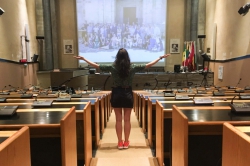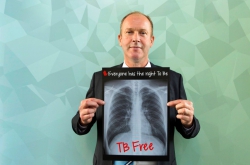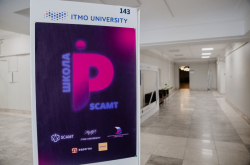The International School of Science Journalism in Erice is a summer school organized by Ettore Majorana Foundation and Centre for Scientific Culture (EMFCSC) with support from the Centro Fermi Institute of Nuclear Physics and Le Scienze science magazine. Each year, the school offers 35 scholarships to young journalists and science communicators. This year, the school’s theme was "What’s Next: Challenges and Opportunities for Tomorrow’s Fundamental Physics".
The school’s educational course includes both lectures and interactive laboratories organized by international experts in the field of research, journalism, and communication. Among this year’s distinguished lecturers was astrophysicist Marica Branchesi, who was included in TIME’s most influential people of 2018 list. Dutch science communicator Fred Balvert and British journalist Robin McKie, as well as other experts, gave workshops on science communication.

“The School of Science Journalism in Erice has been my first international experience. Yet again, I realized that science communication in Russia is rapidly developing, and is moving in the right direction, which is good news. If I were to compare Russia, Europe and the more faraway countries (there were participants from Brazil, India, Egypt, and Israel at the school), I would say that we are all similar and yet very different at the same time. For instance, Brazilians (much like Russians) can’t name even one compatriot scientist and have no idea which fields of research are being developed in their country. In Portugal, science communication appeared 20 years ago, but they still have discussions concerning what it really is and why scientists need it. On the other hand, many topics that are currently relevant in Europe seem far-fetched to us: the current state of science communication in Russia is decades “younger” than that of the UK. For instance, the role of women in science is a hot topic in Europe: quotas on the percentage of women employed in science, the “glass ceiling” and so on. For instance, we’ve learned that in Europe, if a science communicator has to take three comments from different scientists, at least one of them has to be female. In Russia, we don’t pay attention to such issues. Such polarity has its advantages: we can study the approaches used by our more experienced colleagues and make use of them. Still, it’s important to remember that each country has its peculiarities: its scientific history, agenda, political regime, so even the most successful cases have to be adapted to particular circumstances,” comments Ksenia Zhirnova.

The lectures at the school were divided in three categories: science lectures, media lectures and interactive sessions where participants from different countries discussed relevant problems in science communication and searched for possible solutions. This year’s theme was fundamental physics; the participants got to learn about detection of gravity waves, new stars, development of the most powerful free-electron laser and other key topics of modern science from top scientists. Media lectures focused on the specifics of science communicators’ work and its different formats. For example, one of the lecturers spoke about searching for real life stories behind science journalism which he tries to tell in his articles. According to Daniil Shirokov, such formats are rarely used in Russian science journalism.
Still, it were not the lectures but the networking that the school’s participants found most useful. Informal communication between each other provided insight into the current state of science communication in the world and establish useful contacts.

“Networking is a really important part of the summer school. It’s great that not just science communicators, but also representatives of particular fields of science participate in the school, as it makes it possible to combine different competencies. In fact, the participants spend little time in the groups they arrive with, only about half of the first day. The school’s schedule is organized in such a way that you only spend the first half of the day on lectures, and it’s up to you to decide what to do with the second half. The Erice commune is located some 800 meters above the sea level, and is populated by about 30,000 inhabitants - you can see it all in a day, so you spend most of the time communicating with other participants and establishing useful contacts. I made friends with astronomers from Denmark, then one Brit and several Italians joined our group. Amazingly, people from different countries and with different backgrounds all use similar instruments of science communication. I believe that this field is most international in its nature,” comments Daniil Shirokov.
The participants reinforced new knowledge by working on interactive practical assignments. For instance, they worked in groups of four to five people studying a certain topic and writing a pitch for a particular target audience. According to the participants, such practice was very useful as it focused on the challenges that science communicators face on a daily basis.

In order to participate in the course, one has to comply with several criteria. The school’s organizers pay attention to one’s experience with science, science journalism or science communication, which has to be reflected in a detailed resume. Another part of the application is a motivation letter in English.




